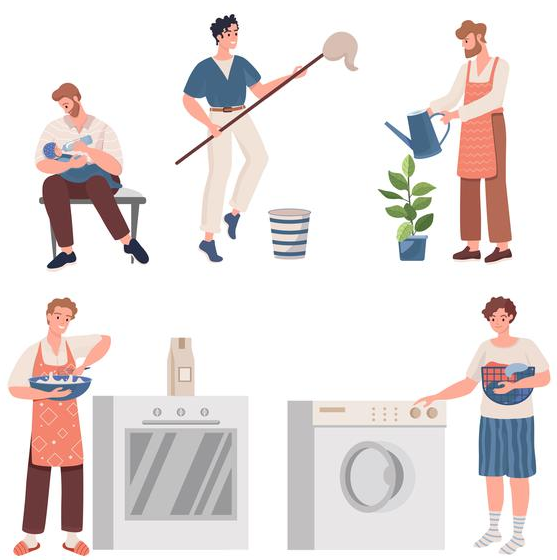Bài học cùng chủ đề
Báo cáo học liệu
Mua học liệu
Mua học liệu:
-
Số dư ví của bạn: 0 coin - 0 Xu
-
Nếu mua học liệu này bạn sẽ bị trừ: 2 coin\Xu
Để nhận Coin\Xu, bạn có thể:

Practice SVIP
Choose the correct answer.
- What's your neighbourhood like?
- ____________.
Choose the correct answer.
Mai: What are you doing, Leo?
Leo: I _________ to my parents. I _________ to them every weekend.
Choose the correct answer.
Nam: What time do you usually finish working?
Bac: Normally I _________ working at five o'clock, but this week I _________ until six to earn a bit more money.
Choose the correct answer.
Anna: I think we're going the wrong way.
Neil: I don't think so. The sun ________ in the east, remember. It's behind us, so we should ________ west.
Look and choose the works the Mom do.

Look at the picture and answer the question.

Does your father do housework in your family?
Listen and choose the correct answer.
1. What is the topic of the programme?
Listen and choose the correct answer.
2. According to Mr. Minh, what is the main job of the woman in a family?
Listen and choose the correct answer.
3. In Ms.Phuong's opinion, how has the role of the members changed in the family?
Listen and choose the correct answer.
4. Does Mr. Nam agree that husbands should share household chores with their wives?
Listen again and answer the question.
Whose opinion do you agree with? Why?
American Family Structure
The average American family has classically been understood as a nuclear family (husband, wife and children) with extended family living separately. While the nuclear family structure is still common today, it can no longer be an exact social expectation as divorce, remarriage, cohabitation of couples and births outside of marriage have become more common. For example, one in six American children under the age of 18 lived with a half sibling in 2014 and almost a quarter (23%) lived in single-parent households as of 2019. Family structures can also vary significantly between different ethnicities and races in America. For example, black children are far more likely to be raised in single parent households than Asian, white and Hispanic children.
The size of immediate families have declined over time as American women have had fewer children. Today, the common cultural preference in America is to have a small family unit with extended family living separately. However, Asian, black and Hispanic families are more likely to live in multigenerational arrangements and have larger households than non-Hispanic white Americans.
Read and choose the correct answer.
1. In America today, people tend to live in _______ families which consist of parents and children.
American Family Structure
The average American family has classically been understood as a nuclear family (husband, wife and children) with extended family living separately. While the nuclear family structure is still common today, it can no longer be an exact social expectation as divorce, remarriage, cohabitation of couples and births outside of marriage have become more common. For example, one in six American children under the age of 18 lived with a half sibling in 2014 and almost a quarter (23%) lived in single-parent households as of 2019. Family structures can also vary significantly between different ethnicities and races in America. For example, black children are far more likely to be raised in single parent households than Asian, white and Hispanic children.
The size of immediate families have declined over time as American women have had fewer children. Today, the common cultural preference in America is to have a small family unit with extended family living separately. However, Asian, black and Hispanic families are more likely to live in multigenerational arrangements and have larger households than non-Hispanic white Americans.
Read and choose the correct answer.
2. Why is the nuclear family no longer an exact social expectation in America?
American Family Structure
The average American family has classically been understood as a nuclear family (husband, wife and children) with extended family living separately. While the nuclear family structure is still common today, it can no longer be an exact social expectation as divorce, remarriage, cohabitation of couples and births outside of marriage have become more common. For example, one in six American children under the age of 18 lived with a half sibling in 2014 and almost a quarter (23%) lived in single-parent households as of 2019. Family structures can also vary significantly between different ethnicities and races in America. For example, black children are far more likely to be raised in single parent households than Asian, white and Hispanic children.
The size of immediate families have declined over time as American women have had fewer children. Today, the common cultural preference in America is to have a small family unit with extended family living separately. However, Asian, black and Hispanic families are more likely to live in multigenerational arrangements and have larger households than non-Hispanic white Americans.
Read and choose the correct answer.
3. Family structures can vary significantly between different _______ and _______ in America.
American Family Structure
The average American family has classically been understood as a nuclear family (husband, wife and children) with extended family living separately. While the nuclear family structure is still common today, it can no longer be an exact social expectation as divorce, remarriage, cohabitation of couples and births outside of marriage have become more common. For example, one in six American children under the age of 18 lived with a half sibling in 2014 and almost a quarter (23%) lived in single-parent households as of 2019. Family structures can also vary significantly between different ethnicities and races in America. For example, black children are far more likely to be raised in single parent households than Asian, white and Hispanic children.
The size of immediate families have declined over time as American women have had fewer children. Today, the common cultural preference in America is to have a small family unit with extended family living separately. However, Asian, black and Hispanic families are more likely to live in multigenerational arrangements and have larger households than non-Hispanic white Americans.
Read and choose the correct answer.
4. Who tend to live in multigenerational families in America?

Bạn có thể đăng câu hỏi về bài học này ở đây
